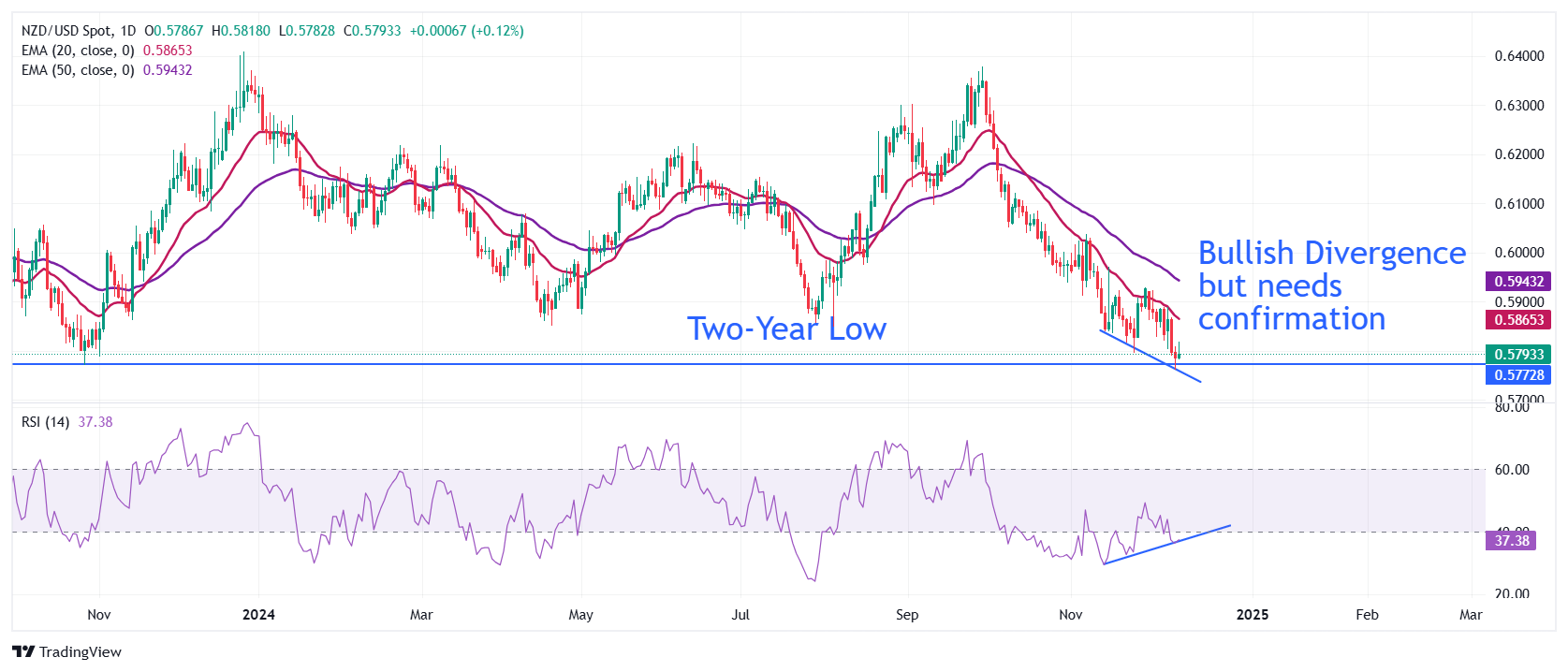NZD/USD Price Forecast: Reversal setup on chart but will unlikely set off
- NZD/USD surrenders daily gains as the US Dollar rebounds despite dovish Fed bets.
- The Kiwi pair exhibits a Bullish Divergence formation but will less likely get triggered.
- The RBNZ has reduced its interest rates by 125 bps to 4.25% this year.
The NZD/USD pair gives up its intraday gains and returns below the round-level figure of 0.5800 in Thursday’s early North American session. The Kiwi pair falls back as the US Dollar (USD) reverses losses even though traders have priced in the Federal Reserve (Fed) to cut interest rates by 25 basis points (bps) to 4.25%-4.50% after the two-day monetary policy meeting on Wednesday.
The Kiwi pair has been battered badly for more than two months and is wobbling near the two-year low. The asset has faced an intense sell-off as the outlook of the New Zealand Dollar (NZD) has weakened, given that the Reserve Bank of New Zealand (RBNZ) has reduced its Official Cash Rate (OCR) aggressively by 125 basis points (bps) to 4.25% in three policy meetings.
The RBNZ was compelled to follow an aggressive policy-easing cycle due to slowing inflationary pressures, weakening labor demand, and poor business activity.
Meanwhile, the US Dollar performs strongly across the board on expectations that policies of higher import tariffs and lower income taxes by President-elect Donald Trump will be inflationary for the United States (US) economy.
NZD/USD daily chart shows a Bullish Divergence formation, which suggests a slowdown in the selling momentum that results in a reversal move. While the asset has formed a lower low formation on a daily timeframe, the 14-day Relative Strength Index (RSI) has made higher lows. The formation needs confirmation to set off a bullish reversal.
A decisive break above the November 29 high of 0.5930 could confirm a reversal setup and push it higher to the November 15 high of 0.5970 and the psychological resistance of 0.6000.
However, the chances of a bullish divergence confirmation are weak due to unsupportive NZ fundamentals, which could take the Kiwi pair lower to the November 2022 low of 0.5740 and the round-level support of 0.5700 if it breaks below the two-year low of 0.5770.
NZD/USD daily chart
New Zealand Dollar FAQs
The New Zealand Dollar (NZD), also known as the Kiwi, is a well-known traded currency among investors. Its value is broadly determined by the health of the New Zealand economy and the country’s central bank policy. Still, there are some unique particularities that also can make NZD move. The performance of the Chinese economy tends to move the Kiwi because China is New Zealand’s biggest trading partner. Bad news for the Chinese economy likely means less New Zealand exports to the country, hitting the economy and thus its currency. Another factor moving NZD is dairy prices as the dairy industry is New Zealand’s main export. High dairy prices boost export income, contributing positively to the economy and thus to the NZD.
The Reserve Bank of New Zealand (RBNZ) aims to achieve and maintain an inflation rate between 1% and 3% over the medium term, with a focus to keep it near the 2% mid-point. To this end, the bank sets an appropriate level of interest rates. When inflation is too high, the RBNZ will increase interest rates to cool the economy, but the move will also make bond yields higher, increasing investors’ appeal to invest in the country and thus boosting NZD. On the contrary, lower interest rates tend to weaken NZD. The so-called rate differential, or how rates in New Zealand are or are expected to be compared to the ones set by the US Federal Reserve, can also play a key role in moving the NZD/USD pair.
Macroeconomic data releases in New Zealand are key to assess the state of the economy and can impact the New Zealand Dollar’s (NZD) valuation. A strong economy, based on high economic growth, low unemployment and high confidence is good for NZD. High economic growth attracts foreign investment and may encourage the Reserve Bank of New Zealand to increase interest rates, if this economic strength comes together with elevated inflation. Conversely, if economic data is weak, NZD is likely to depreciate.
The New Zealand Dollar (NZD) tends to strengthen during risk-on periods, or when investors perceive that broader market risks are low and are optimistic about growth. This tends to lead to a more favorable outlook for commodities and so-called ‘commodity currencies’ such as the Kiwi. Conversely, NZD tends to weaken at times of market turbulence or economic uncertainty as investors tend to sell higher-risk assets and flee to the more-stable safe havens.

